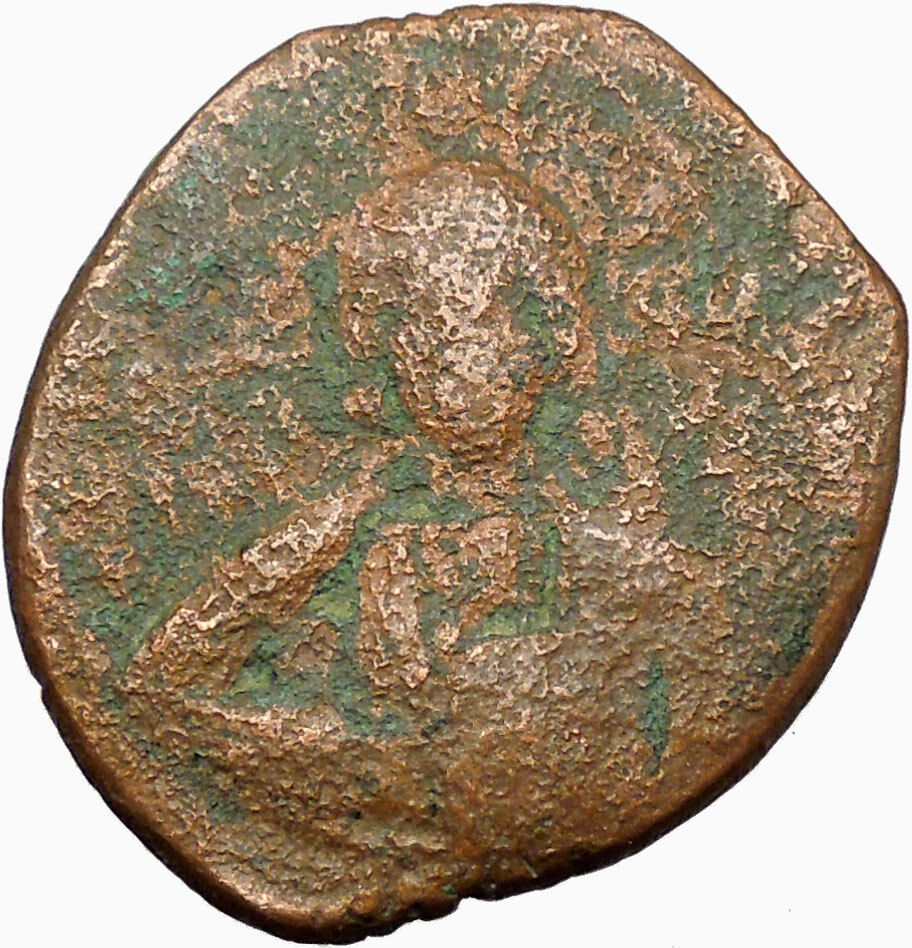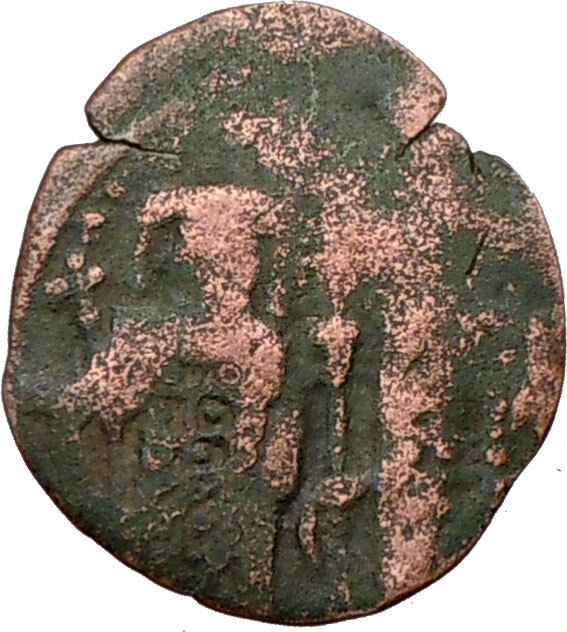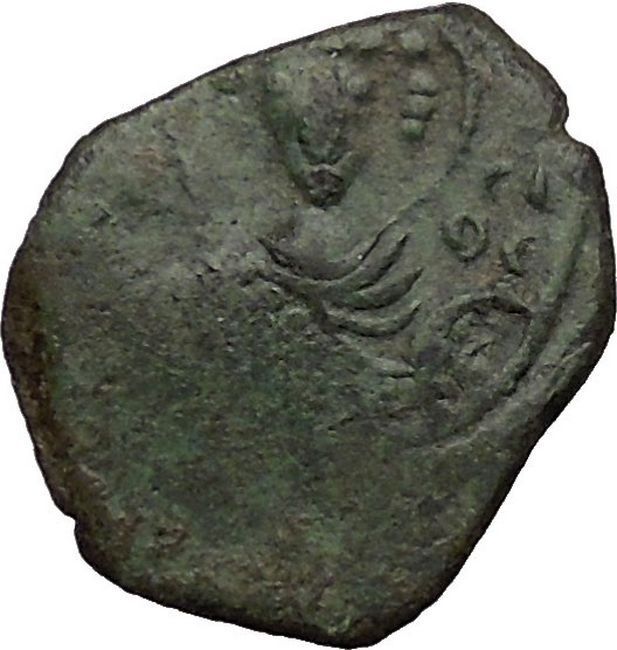|
Constantine
X – Byzantine Emperor: 25 December 1059 – 21 May
1067 A.D. –
Bronze Follis 30mm (8.88 grams) Struck at the mint of Constantinople circa 1059-1067 A.D.
Reference: Sear 1854
┼ЄMMANOVHΛ. – Bust of Christ facing, wearing nimbus crown,
pallium and colobium, and raising
right hand in benediction; in left hand, book
of Gospels; to left, IC; to
right, XC.
┼KWN RACIΛЄVC O ΔOVK – Bust facing,
bearded, wearing crown and loros,
and holding cross and akakia.
You are bidding on the exact item pictured,
provided with a Certificate of Authenticity and Lifetime Guarantee of
Authenticity.
Constantine X Doukas or Ducas (Greek:
Κωνσταντίνος Ι΄ Δούκας, Kōnstantinos X Doukas),
(1006 – May, 1067) was emperor of the
Byzantine Empire
from 1059 to 1067.
Reign
Constantine Doukas was the son of Andronikos Doukas, a
Paphlagonian
nobleman who may have served as governor of the theme of
Moesia
.
Constantine gained influence after he married, as his second wife,
Eudokia Makrembolitissa
, the niece of Patriarch
Michael Keroularios
. In 1057, Constantine supported the usurpation of
Isaac I Komnenos
, but gradually sided with the court bureaucracy against the
new emperor’s reforms. In spite of this tacit opposition, Constantine was chosen
as successor by the ailing Isaac in November, 1059, under the influence of
Michael Psellos
. Isaac abdicated and on
November
24
, 1059
,
Constantine X Doukas was crowned emperor.
The new emperor quickly associated two of his young sons in power, appointed
his brother
John Doukas
as kaisar (Caesar)
and embarked on a policy favorable to the interests of the court bureaucracy and
the church. Severely undercutting the training and financial support for the
armed forces, Constantine X fatally weakened Byzantine defences (by disbanding
the Armenian local militia of 50,000 men) at a crucial point of time, coinciding
with the westward advance of the
Seljuk Turks
and their Turcoman allies.
Constantine became naturally unpopular with the supporters of Isaac within
the military aristocracy, who attempted to assassinate him in 1061; he was also
unpopular with the general population, after he raised taxes to try to pay the
army at long last.
Constantine lost most of Byzantine
Italy
to the
Normans
under
Robert Guiscard
, except for the territory around
Bari, though a
resurgence of interest in retaining
Apulia
occurred
under his watch and he appointed at least four
catepans of Italy
:
Miriarch
,
Maruli
,
Sirianus
,
and
Mabrica
. He also suffered invasions from
Alp Arslan
in
Asia Minor
in 1064 and the
Uzes
in the Balkans
in 1065. Already old and unhealthy when he came to power, he died on
May 22
,
1067 and was
succeeded by his young sons under the regency of their mother Eudokia
Makrembolitissa.
|
Jesus |
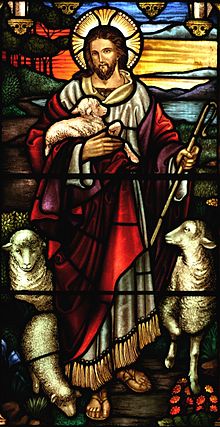
Jesus depicted as
the Good
Shepherd
(stained
glass at St
John’s Ashfield) |
| Born |
7–2 BC
Judea, Roman
Empire |
| Died |
30–36 AD
Judea, Roman Empire |
Cause of
death |
Crucifixion |
| Home town |
Nazareth, Galilee |
Jesus (//; Greek: Ἰησοῦς Iesous;
7–2 BC to 30–36 AD), also referred to as Jesus
of Nazareth, is the central figure of Christianity,
whom the teachings of most Christian
denominations hold to be the Son
of God. Christians believe Jesus
to be the awaited Messiah of
the Old
Testament and refer to him as Jesus
Christ or simply Christ, a
name that is also used by non-Christians.
Virtually all modern scholars of antiquity agree that a historical
Jesus existed, although there
is little agreement on the reliability
of the gospel narratives and
their assertions of his divinity. Most
scholars agree that Jesus was a Jewishteacher
from Galilee, was
baptized by John
the Baptist, and was
crucified in Jerusalem on
the orders of the Roman
prefect, Pontius
Pilate. Scholars have constructed
various portraits of the historical
Jesus, which often depict him as having one or more of the following roles:
the leader of an apocalyptic movement,
Messiah, a charismatic healer, a sage and philosopher, or an egalitarian social
reformer. Scholars have
correlated the New
Testament accounts with
non-Christian historical records to arrive at an estimated chronology
of Jesus’ life.
Most Christians believe that Jesus was conceived by the Holy
Spirit, born
of a virgin, performed miracles,
founded the
Church, died by crucifixion as a sacrifice to achieve atonement, rose
from the dead, and ascended into heaven,
from which hewill
return. The majority of
Christians worship Jesus as the incarnation of God
the Son, who is the Second Person of the Holy
Trinity. A few Christian groups reject
Trinitarianism, wholly or partly, as non-scriptural.
In Islam, Jesus (commonly transliterated as Isa)
is considered one of God’s important prophets. To
Muslims, Jesus is a bringer
of scripture and the child of a
virgin birth, but neither divine nor the victim of crucifixion. Judaism rejects the
belief that Jesus was the awaited Messiah, arguing that he did not fulfill the Messianic
prophecies in the Tanakh. Bahá’í scripture
almost never refers to Jesus as the Messiah, but calls him a Manifestation
of God.
Etymology of names
A typical Jew in Jesus’ time had only one name, sometimes supplemented with the
father’s name or the individual’s hometown. Thus,
in the Christian
Bible, Jesus is referred to as “Jesus of Nazareth” (Matthew
26:71), “Joseph’s son” (Luke
4:12), and “Jesus of Nazareth, the son of Joseph” (John
1:45). The name Jesus,
which occurs in a number of languages, is derived from the Latin Iesus,
a transliteration of
the Greek Ἰησοῦς (Iesous). The
Greek form is a rendition of the Aramaic ישוע
(Yeshua), which is derived from the Hebrew יהושע
(Yehoshua). The nameYeshua appears
to have been in use in Judea at the time of the birth of Jesus. The
first-century works of historian Flavius
Josephus refer to at least twenty
different people with this name. The
etymology of Jesus’ name in the context of the New Testament is generally given
as “Yahwehsaves”,
“Yahweh will save”, or “Yahweh is salvation”.
Since early Christianity, Christians have commonly referred to Jesus as “Jesus
Christ”. The word Christ is
derived from the Greek Χριστός (Christos), which
is a translation of the Hebrew מָשִׁיחַ (Masiah),
meaning the “anointed”
and usually transliterated into English as “Messiah”. Christians
designate Jesus as Christ because they believe he is the awaited Messiah prophesied in
the Hebrew
Bible (Old Testament). In
postbiblical usage, Christ became
viewed as a name—one part of “Jesus Christ”—but originally it was a title. Since
the first century, the term “Christian” (meaning “one who owes allegiance to the
person of Christ”) is used to identify the followers of Jesus.
Chronology
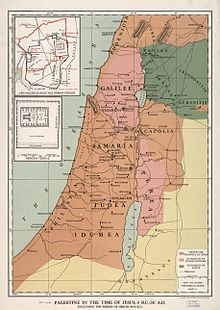
Judea and Galilee at
the time of Jesus
Most scholars agree that Jesus was a Galilean Jew who
was born around the beginning of the first century and died between 30 and 36 AD
in Judea. Amy-Jill
Levine states that the general
scholarly consensus is that Jesus was a contemporary of John
the Baptist and was crucified by
Roman governor Pontius
Pilate, who reigned from 26 to 36 AD. Most
scholars hold that Jesus lived in Galilee and Judea and did not preach or study
elsewhere.
The gospels offer several clues concerning the year of Jesus’ birth. Matthew
2:1 associates the birth of Jesus
with the reign of Herod
the Great, who died around 4 BC, and Luke
1:5 mentions that Herod was on
the throne shortly before the birth of Jesus. Luke’s
gospel also associates the birth with the Census
of Quirinius. Luke
3:23 states that Jesus was “about
thirty years of age” at the start of his ministry, which according to Acts
10:37–38 was preceded by John’s
ministry, which according to Luke
3:1–2 began in the 15th year of
Tiberius’ reign (28 or 29 AD). By
collating the gospel accounts with historical data, along with using various
other methods, most scholars arrive a date of birth between 6 and 4 BC, but
some propose a wider range between 7 and 2 BC.
The years of Jesus’ ministry have been estimated using several different
approaches. One approach applies the
reference in Luke
3:1–2, Acts
10:37–38 and the dates of
Tiberius’ reign, which are well known. This gives a date of around 28–29 AD for
the start of Jesus’ ministry. Another
approach uses the statement about the temple in John
2:13–20, which states that the temple
in Jerusalem was in its 46th year
of construction at the start of Jesus’ ministry, together withJosephus’
statement that the temple’s
reconstruction was started by Herod in the 18th year of his reign, to estimate a
date around 27–29 AD. Another method
uses the date of the death
of John the Baptist and the
marriage of Herod Antipas toHerodias,
based on the writings of Josephus, and correlates it with Matthew
14:4 and Mark
6:18. Given that most scholars
date the marriage of Herod and Herodias as AD 28–35, this yields a date about
28–29 AD.
A number of approaches have been used to estimate the year of the Crucifixion of
Jesus, leading most scholars to agree that he died between 30 and 36 AD. The
gospels state that the event occurred during the prefecture of Pilate, who was
the Roman governor of Judea from 26 AD until 36 AD. Scholars
believe the Crucifixion occurred before the conversion
of Paul, which is estimated at around 33–36 AD. Astronomers
since Isaac
Newton have tried to estimate the
precise date of the Crucifixion, the most widely accepted dates being April 7,
30 AD, and April 3, 33 AD (both Julian).
Life and
teachings in the New Testament
The four canonical
gospels (Matthew, Mark, Luke,
and John)
are the main sources for the biography of Jesus, but other parts of the New
Testament, such as the Pauline
epistles, which were probably written decades before the gospels, also
include references to key episodes in his life, such as the Last
Supper in 1
Corinthians 11:23–26. The Acts
of the Apostles (10:37–38 and 19:4)
refers to the early ministry of Jesus and its anticipation by John the Baptist. Acts
1:1–11 says more about the Ascension
of Jesus (also mentioned in 1
Timothy 3:16) than the canonical gospels do.
Canonical gospel
accounts
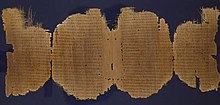
A 3rd-century Greek papyrus of Luke
Not everything contained in the New Testament gospels is considered to be
historically reliable. Elements whose
historical authenticity are disputed include the two accounts of the Nativity,
as well as the Resurrection and certain details about the Crucifixion. Views
on the gospels range from their being inerrant descriptions
of the life of Jesus to their
providing no historical information about his life.
Three of the four canonical gospels, Matthew, Mark, and Luke, are known as the Synoptic
Gospels, from the Greek σύν (syn “together”)
and ὄψις (opsis “view”). According
to the majority viewpoint, the Synoptic Gospels are the primary sources of
historical information about Jesus. They
are very similar in content, narrative arrangement, language and paragraph
structure. Scholars generally agree
that it is impossible to find any direct literary relationship between the
Synoptic Gospels and the Gospel of John.
In general, the authors of the New Testament showed little interest in an
absolute chronology of Jesus or in synchronizing the episodes of his life with
the secular history of the age. As
stated in John
21:25, the gospels do not claim to provide an exhaustive list of the events
in the life of Jesus. The accounts
were primarily written as theological documents in the context of early
Christianity, with timelines as a secondary consideration. One
manifestation of the gospels as theological documents rather than historical
chronicles is that they devote about one third of their text to just seven days,
namely the last week of the life of Jesus in Jerusalem, referred to as Passion
Week. Although the gospels do not
provide enough details to satisfy the demands of modern historians regarding
exact dates, it is possible to draw from them a general picture of the life
story of Jesus.
The gospel accounts sometimes differ in the ordering of the parables, miracles,
and other events. While the flow of
the some events, such as the Baptism, Transfiguration,
and Crucifixion of
Jesus, and his interactions with the Apostles, are shared among the Synoptic
Gospels, events such as the Transfiguration do not appear in John’s Gospel,
which also differs on other matters, such as the Cleansing
of the Temple. Since the second
century, attempts have been made to harmonize the
gospel accounts into a single narrative, Tatian’s Diatesseron perhaps
being the first.
The gospels include a number of discourses by Jesus on specific occasions, such
as the Sermon
on the Mount and the Farewell
Discourse. They also include over 30 parables spread throughout the
narrative, often with themes that relate to the sermons. John
14:10 stresses the importance of
the words of Jesus and attributes them to the authority of God the Father. The
gospel descriptions of Jesus’ miracles are often accompanied by records of his
teachings.
Genealogy and Nativity

“Adoration of the Shepherds” by Gerard
van Honthorst, 1622
Accounts of the genealogy and
Nativity of Jesus appear in the New Testament only in the gospels of Luke and
Matthew. Outside the New Testament, documents exist that are more or less
contemporary with Jesus and the gospels, but few shed any light on biographical
details of his life, and these two gospel accounts remain the main sources of
information on the genealogy and Nativity.
Matthew begins
his gospel with the genealogy of
Jesus, before giving an account of Jesus’ birth. He traces Jesus’ ancestry to
Abraham through David. Luke
3:22 discusses the genealogy
after describing the Baptism of Jesus, when the voice from Heaven addresses
Jesus and identifies him as the Son
of God. Luke traces Jesus’ ancestry through Adam to
God.
The Nativity is a prominent element in the Gospel of Luke, comprising over 10
percent of the text and being three times as long as Matthew’s Nativity text. Luke’s
account emphasizes events before the birth of Jesus and centers on Mary, while
Matthew’s mostly covers those after the birth and centers on Joseph. Both
accounts state that Jesus was born to Joseph and Mary,
his betrothed,
in Bethlehem,
and both support the doctrine of the virgin
birth, according to which Jesus was miraculously conceived by the Holy
Spirit in Mary’s womb when she was still a virgin.
In Luke
1:31–38 Mary learns from the
angel Gabriel that
she will conceive and bear a child called Jesus through the action of the Holy
Spirit. Following his betrothal to
Mary, Joseph is troubled (Matthew
1:19–20) because Mary is pregnant, but in the first of Joseph’s
three dreams an angel assures him
not be afraid to take Mary as his wife, because her child was conceived by the
Holy Spirit. When Mary is due to give
birth, she and Joseph travel from Nazareth to
Joseph’s ancestral home in Bethlehem to register in the census of Quirinius.
There Mary gives birth to Jesus, and as they have found no room in the inn, she
places the newborn in a manger (Luke
2:1–7). An angel
visits some shepherds and sends
them to adore
the child (Luke
2:22). After presenting Jesus at the Temple, Joseph and Mary return home to
Nazareth. In Matthew
1:1–12, wise
men or Magi from
the East bring gifts to the young Jesus as the King
of the Jews. Herod hears of Jesus’ birth and, wanting him killed, orders the murder
of young male children in Bethlehem. But an angel warns Joseph in his second
dream, and the family flees
to Egypt, later to return and settle in Nazareth.
Early life and
profession
Jesus’ childhood home is identified in the gospels of Luke and Matthew as the
town of Nazareth in Galilee. Mary’s husband Joseph appears in descriptions of
Jesus’ childhood, but no mention is made of him thereafter. The
New Testament books of Matthew, Mark, and Galatians mention
Jesus’ brothers and sisters, but the Greek word adelphos in
these verses has also been translated as “kinsman”, rather than the more usual
“brother”.
Originally written in Koine
Greek, the Gospel of Mark calls Jesus in Mark
6:3 a τέκτων (tekton),
usually understood to mean a carpenter, and Matthew
13:55 says he was the son of a tekton. Although
traditionally translated as “carpenter”, tekton is
a rather general word (from the same root that leads to “technical” and
“technology”) that could cover makers of objects in various materials, even
builders. Beyond the New Testament
accounts, the association of Jesus with woodworking is a constant in the
traditions of the first and second centuries. Justin
Martyr (d. ca. 165) wrote that
Jesus made yokes and ploughs.
Baptism and temptation

Trevisani’s depiction of the typical baptismal scene with the
sky opening and the Holy Spirit descending as a dove, 1723
Gospel accounts of the Baptism of Jesus are always preceded by information about
John the Baptist and his ministry. They
show John preaching penance and repentance for the remission of sins and
encouraging the giving of alms to
the poor (Luke
3:11) as he baptized people in the area of the River
Jordan around Perea at
about the time when Jesus began his ministry. The Gospel of John (1:28)
initially specifies “Bethany beyond the Jordan”, that is Bethabara in
Perea, and later John
3:23 refers to further baptisms
in Ænon “because
there was much water there”.
In the gospels, John had been foretelling (Luke
3:16) the arrival of someone “mightier than I”, and Paul
the Apostle also refers to this (Acts
19:4). In Matthew
3:14, on meeting Jesus, the Baptist says, “I have need to be baptized of
thee”, but Jesus persuades John to baptize him nonetheless. After
he does so and Jesus emerges from the water, the sky opens and a voice from
Heaven states, “This is my beloved Son in whom I am well pleased” (Matthew
3:17). The Holy Spirit then descends upon Jesus as a dove. In John
1:29–33, rather than a direct narrative, the Baptist bears witness to the
episode. This is one of two events
described in the gospels where a voice from Heaven calls Jesus “Son”, the other
being the Transfiguration.
After the baptism, the Synoptic Gospels describe the Temptation
of Christ, in which Jesus resisted temptations from the
devil while fasting for forty
days and nights in the Judaean
Desert. The Gospel of John omits
the Temptation and proceeds directly to the first encounter between Jesus and
two of his future disciples (John
1:35–37): on the day after the Baptism, the Baptist sees Jesus again and
calls him the Lamb
of God; two disciples of John the Baptist hear this and follow Jesus.
Ministry

A 19th-century painting depicting the Sermon on the Mount by Carl
Bloch
The gospels present John the Baptist’s ministry as the precursor of that of
Jesus. Starting with his Baptism, Jesus begins his ministry in the countryside
of Judea, near the River Jordan, when he is “about thirty years of age” (Luke
3:23). He then travels, preaches and performs miracles, eventually
completing his ministry with the Last Supper with his disciples in Jerusalem.
Scholars divide the ministry of Jesus into several stages. The Galilean ministry
begins when Jesus returns to Galilee from the Judaean Desert after rebuffing the
temptation of Satan. Jesus preaches around Galilee, and in Matthew
4:18–20, his
first disciples, who will eventually form the core of the early Church,
encounter him and begin to travel with him. This
period includes the Sermon on the Mount, one of Jesus’ major discourses. This
period also includes the Calming
the storm, Feeding
the 5000, Walking
on water, and a number of other miracles and parables. This
period ends with the Confession
of Peter and the Transfiguration.
As Jesus travels towards Jerusalem, in the Perean ministry,
he returns to the area where he was baptized, about one-third the way down from
the Sea of Galilee along the Jordan (John
10:40–42). The final
ministry in Jerusalem begins with
the Jesus’ triumphal entry into Jerusalem on Palm
Sunday. In the Synoptic Gospels,
during that week Jesus drives the money changers from the Temple and Judas
bargains to betray him. However,
John’s Gospel places the Temple incident during the early part of Jesus’
ministry, and scholars differ on whether these are one or two separate
incidents. This period culminates in
the Last Supper and the Farewell Discourse.
Teachings and preachings

Jesus cleansing a leper –
medieval mosaic from
theMonreale
Cathedral
Commentaries often discuss the teachings of Jesus in terms of his “words and
works”. The words include a number of
sermons, as well as parables that appear throughout the narrative of the
Synoptic Gospels (the Gospel of John includes no narrative parables). The works
include the miracles and other acts performed during Jesus’ ministry. Although
the canonical gospels are the major source of the teachings of Jesus, the
Pauline epistles provide some of the earliest written accounts.
The New Testament presents the teachings of Jesus not merely as his own
preaching, but as divine revelation. John the Baptist, for example, states in John
3:34: “For he whom God hath sent speaketh the words of God: for he giveth
not the Spirit by measure.” In John
7:16 Jesus says, “My teaching is
not mine, but his that sent me.” He asserts the same thing in John
14:10: “Believest thou not that I am in the Father, and the Father in me?
the words that I say unto you I speak not from myself: but the Father abiding in
me doeth his works.” In Matthew
11:27 Jesus claims divine
knowledge, stating: “no one knoweth the Son, save the Father; neither doth any
know the Father, save the Son”.
The Kingdom of God (also called the Kingdom of Heaven in Matthew) is one of the
key elements of Jesus’ teachings in the New Testament. Jesus
promises inclusion in the Kingdom for those who accept his message. He calls
people to repent their sins and to devote themselves completely to God. Jesus
tells his followers to adhere strictly to Jewish
law, although he has broken the law himself, especially regarding the Sabbath. When
asked what the greatest commandment is, Jesus replies: “Thou shalt love the Lord
thy God with all thy heart, and with all thy soul, and with all thy mind … And
a second like [unto it] is this, Thou shalt love thy neighbor as thyself” (Matthew
22:37–39). Other ethical teachings of Jesus include loving
one’s enemies, refraining from hatred and lust, and turning
the other cheek (Matthew
5:21–44).
In the gospels, the approximately thirty parables form about one third of Jesus’
recorded teachings. The parables
appear within longer sermons and at other places in the narrative. They
often contain symbolism, and usually relate the physical world to the spiritual. Common
themes in these tales include the kindness and generosity of God and the perils
of transgression. Some of his
parables, such as the Prodigal
Son (Luke
15:11–32), are relatively simple, while others, such as theGrowing
Seed (Mark
4:26–29), are more abstruse.
The gospel episodes that include descriptions of the miracles of Jesus also
often include teachings, and the miracles themselves involve an element of
teaching. Many of the miracles teach
the importance of faith. In the cleansing
of ten lepers and the raising
of Jairus’ daughter, for instance, the beneficiaries are told that their
healing was due to their faith. When
Jesus’ opponents accuse him of performing exorcisms by the power of Beelzebul,
the prince of demons, Jesus counters that he performs miracles by the “Spirit of
God” (Matthew
12:28) or “finger of God” (Luke
11:20).
Proclamation as Christ and Transfiguration
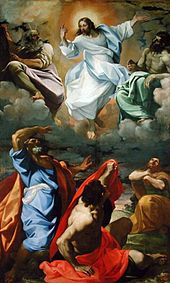
Transfiguration of Jesusdepicting him with Elijah, Mosesand
3 apostles by Carracci,
1594
At about the middle of each of the three Synoptic Gospels, two related episodes
mark a turning point in the narrative: the Confession of Peter and the
Transfiguration of Jesus. They take
place near Caesarea
Philippi, just north of the Sea
of Galilee, at the beginning of the final journey to Jerusalem that
ends in the Passion and Resurrection
of Jesus. These events mark the
beginnings of the gradual disclosure of the identity of Jesus to his disciples
and his prediction of his own suffering and death.
Peter’s Confession begins as a dialogue between Jesus and his disciples in Matthew
16:13, Mark
8:27 and Luke
9:18. Jesus asks his disciples, “who say ye that I am?” Simon Peter answers,
“Thou art the Christ, the Son of the living God” (Matthew
16:15–16). Jesus replies,
“Blessed art thou, Simon Bar-jonah: for flesh and blood hath not revealed it
unto thee, but my Father who is in heaven.” With this blessing, Jesus affirms
that the titles Peter ascribes to him are divinely revealed, thus unequivocally
declaring himself to be both Christ and the Son of God.
The account of the Transfiguration appears in Matthew
17:1–9, Mark
9:2–8, and Luke
9:28–36. Jesus takes Peter and
two other apostles up an unnamed mountain, where “he was transfigured before
them; and his face did shine as the sun, and his garments became white as the
light.” A bright cloud appears around
them, and a voice from the cloud says, “This is my beloved Son, in whom I am
well pleased; hear ye him” (Matthew
17:1–9). The Transfiguration
reaffirms that Jesus is the Son of God (as in his Baptism), and the command
“hear ye him” identifies him as God’s messenger and mouthpiece.
Final week: betrayal, arrest, trial, and death
The description of the last week of the life of Jesus (often called Passion
Week) occupies about one third of the narrative in the canonical gospels, starting
with a description of the Triumphal
entry into Jerusalem and ending
with his Crucifixion.The last week in Jerusalem is the conclusion of the journey
through Perea and Judea that Jesus began in Galilee. Just
before the entry into Jerusalem, the Gospel of John includes the Raising
of Lazarus, which increases the tension between Jesus and the authorities.
Final entry into
Jerusalem
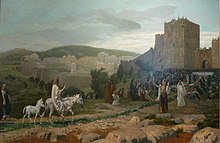
A painting of Jesus’ final entry into Jerusalem, by Jean-Léon
Gérôme in 1897
In the four canonical gospels, Jesus’ final entry into Jerusalem takes place at
the beginning of the last week of his life, a few days before the Last Supper,
marking the beginning of the Passion narrative. The
day of entry into Jerusalem is identified by Mark and John as Sunday and by
Matthew as Monday; Luke does not identify the day. After
leaving Bethany Jesus
rides a young donkey into Jerusalem. People along the way lay cloaks and small
branches of trees in front of him and sing part of Psalm
118:25–26. The cheering crowds
greeting Jesus as he enters Jerusalem add to the tension between him and the
authorities.
In the three Synoptic Gospels, entry into Jerusalem is followed by the Cleansing
of the Temple, in which Jesus expels the money changers from the temple,
accusing them of turning it into a den of thieves through their commercial
activities. This is the only account of Jesus using physical force in any of the
gospels. John
2:13–16 includes a similar
narrative much earlier, and scholars debate whether the passage refers to the
same episode. The Synoptics include a
number of well-known parables and sermons, such as the Widow’s
mite and the Second
Coming Prophecy, during the week that follows.
The Synoptics record conflicts that took place between Jesus and the Jewish
elders during Passion Week in episodes such as the Authority
of Jesus questioned and the Woes
of the Pharisees, in which Jesus criticizes their hypocrisy.
Judas Iscariot, one of the twelve
apostles, approaches the Jewish elders and strikes a bargain with them, in
which he undertakes to betray Jesus and hand him over to them for a reward of thirty
silver coins.
Last Supper
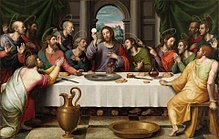
The Last Supper, depicted in this 16th-century painting by Joan de
Joanes.
The Last Supper is the final meal that Jesus shares with his twelve
apostles in Jerusalem before his
crucifixion. The Last Supper is mentioned in all four canonical gospels, and
Paul’s First
Epistle to the Corinthians (11:23–26)
also refers to it. During the meal, Jesus
predicts that one of his apostles
will betray him. Despite each
Apostle’s assertion that he would not betray him, Jesus reiterates that the
betrayer would be one of those present. Matthew
26:23–25 and John
13:26–27 specifically identify
Judas as the traitor.
In the Synoptics, Jesus takes bread, breaks it and gives it to the disciples,
saying, “This is my body which is given for you”. He then has them all drink
from a cup, saying, “This cup is the new covenant in my blood” (Luke
22:19–20). Although the Gospel of John does not include a description of the
bread-and-wine ritual during the Last Supper, most scholars agree that John
6:58–59 (the Bread
of Life Discourse) has a eucharistic character and resonates with the institution
narratives in the Synoptic
Gospels and in the Pauline writings on the Last Supper.
In all four gospels, Jesus predicts that Peter will deny knowledge of him three
times before the rooster crows
the next morning. In Luke and John,
the prediction is made during the Supper (Luke
22:34, John
22:34). In Matthew and Mark, the prediction is made after the Supper, and
Jesus also predicts that all his disciples will desert him (Matthew
26:31–34, Mark
14:27–30). The Gospel of John
provides the only account of Jesus washing his disciples’ feet before the meal. John
also includes a long sermon by Jesus, preparing his disciples (now without
Judas) for his departure. Chapters
14–17 of the Gospel of John are
known as the Farewell
Discourse and are a significant
source of Christological content.
Agony
in the Garden, betrayal and arrest
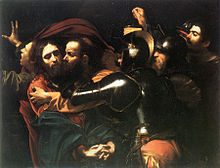
A 17th-century depiction of the kiss of Judas and the arrest of
Jesus byCaravaggio
After the Last Supper, Jesus, accompanied by his disciples, takes a walk to
pray. Matthew and Mark identify the place as the garden
of Gethsemane, while Luke identifies it as the Mount of Olives. Judas
appears in the garden, accompanied by a crowd that includes the Jewish priests
and elders and people with weapons. He kisses
Jesus to identify him to the
crowd, which then arrests
Jesus. In an attempt to stop
them, one of Jesus’ disciples uses a sword to cut off the ear a man in the
crowd. Luke states that Jesus
miraculously heals the wound, and John and Matthew report that Jesus criticizes
the violent act, enjoining his disciples not to resist his arrest. In Matthew
26:52 Jesus says, “all
they that take the sword shall perish with the sword”. After
Jesus’ arrest, his disciples go into hiding, and Peter, when questioned, thrice
denies knowing Jesus. After the third
denial, he hears the rooster crow and recalls the prediction as Jesus turns to
look at him. Peter then weeps bitterly.
Trials by the Sanhedrin, Herod and Pilate

Jesus in the upper right hand corner, his hands bound behind, is
being tried at the high priest’s house and turns to look at Peter,
in Rembrandt’s
1660 depiction ofPeter’s
denial.
After his arrest, Jesus is taken to the Sanhedrin,
a Jewish judicial body. The gospel
accounts differ on the details of the trials. In Matthew
26:57, Mark
14:53 and Luke
22:54, Jesus is taken to the high priest’s house, where he is mocked and
beaten that night. Early next morning, the chief priests and scribes lead Jesus
away into their council. John
18:12–14 states that Jesus is
first taken to Annas,
the father-in-law of Caiaphas, and then to Caiaphas. All
four gospels report the Denial
of Peter, where Peter denies knowing Jesus three times before the rooster
crows, as predicted by Jesus.
During the trials Jesus speaks very little, mounts no defense and gives very
infrequent and indirect answers to the questions of the priests, prompting an
officer to slap him. In Matthew
26:62 Jesus’ unresponsiveness
leads the high priest to ask him, “Answerest thou nothing?” In Mark
14:61 the high priest then asks
Jesus, “Art thou the Christ, the Son of the Blessed?”. Jesus replies “I am” and
then predicts the coming of the Son
of Man. This provokes the high
priest to tear his own robe in anger and to accuse Jesus of blasphemy. In
Matthew and Luke, Jesus’ answer is less direct. In Matthew
26:64 he responds “Thou hast
said”, and in Luke
22:70 he says, “Ye say that I
am”.
Taking Jesus to Pilate’s
Court, the Jewish elders ask Roman governor Pontius Pilate to judge and
condemn Jesus, accusing him of claiming to be the King of the Jews. The
use of the word “king” is central to the discussion between Jesus and Pilate. In John
18:36 Jesus states, “My kingdom
is not of this world”, but he does not directly deny being the King of the Jews. In Luke
23:7–15 Pilate realizes that
Jesus is a Galilean, thus coming under the jurisdiction of Herod Antipas. Pilate
sends Jesus to Herod to be tried, but
Jesus says almost nothing in response to Herod’s questions. Herod and his
soldiers mock Jesus, put a gorgeous robe on him to make him look like a king,
and send him back to Pilate. Pilate
then calls together the Jewish elders and says that he has “found no fault in
this man”.
As a Passover custom,
Pilate allows one prisoner chosen by the crowd to be released. He gives the
crowd a choice between Jesus and a murderer called Barabbas. Persuaded by the
elders (Matthew
27:20), the mob chooses to release Barabbas and crucify Jesus. Pilate
writes a sign that reads “Jesus of Nazareth, King of the Jews” (abbreviated as INRI in
depictions) to be affixed to the cross of Jesus (John
19:19). He then scourges
Jesus and send him to be
cricified. The soldiers mock Jesus as the King of Jews by clothing him in a
purple robe (which signifies royal status) and placing a Crown
of Thorns on his head. They beat
and taunt him before taking him to Calvary, also
called Golgotha, for crucifixion.
Crucifixion and burial
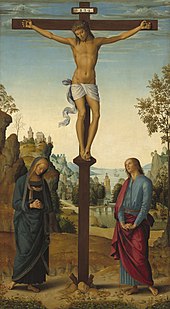
Pietro Perugino’s depiction of the Crucifixion as Stabat
Mater, 1482
Jesus’ crucifixion is described in all four canonical gospels. After the trials,
Jesus makes his way to Calvary by a route known traditionally as the Via
Dolorosa. The three Synoptic Gospels indicate that Simon
of Cyrene assists him, having
been compelled by the Romans to do so. In Luke
23:27–28 Jesus tells the women in
the multitude of people following him not to weep for him but for themselves and
their children. At Calvary Jesus is
offered wine mixed with gall, a concoction usually offered as a painkiller.
Matthew and Mark state that he refuses it.
The soldiers then crucify Jesus and cast lots for his clothes. Above Jesus’ head
on the cross is Pilate’s inscription “Jesus of Nazareth, King of the Jews”, and
the soldiers and passers-by mock him about it. Jesus is crucified between two
convicted thieves, one of whom rebukes Jesus, while the other defends him. The
Roman soldiers break the two thieves’ legs (a procedure designed to hasten death
in a crucifixion), but they do not break those of Jesus, as he is already dead.
One soldier, traditionally identified as Saint
Longinus, pierces Jesus’ side with a lance, and water flows out. In Mark
15:39, impressed by the events, the Roman centurion affirms
that Jesus was the Son of God.
On the same day, Joseph
of Arimathea, with Pilate’s permission and with Nicodemus’
help, removes
Jesus’ body from the cross, wraps him in a clean cloth and buries him in a
new rock-hewn
tomb. In Matthew
27:62–66, on the following day the Jews ask Pilate for the tomb to be sealed
with a stone and placed under guard to ensure the body will remain there.
Resurrection and
ascension
New Testament accounts of Jesus’ resurrection state that on the first day of the
week after the crucifixion (typically interpreted as a Sunday), his tomb is
discovered to be empty and his followers encounter him risen from the dead. His
followers arrive at the tomb early in the morning and meet either one or two
beings (men or angels) dressed in bright robes. Mark
16:9 and John
20:15 indicate that Jesus appears
to Mary
Magdalene first, and Luke
16:9 states that she is one of
themyrrhbearers.
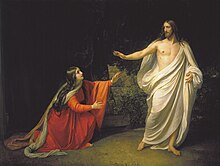
Mary Magdalene’s encounter with Jesus after his resurrection,
depicted byAlexander
Andreyevich Ivanov in
1835
After the discovery of the empty tomb, Jesus makes a series of appearances to
the disciples. These include the Doubting
Thomas episode and the appearance
on the road to Emmaus, where Jesus meets two disciples. The catch
of 153 fish is a miracle by the
Sea of Galilee, after which Jesus encourages Peter to serve his followers.
Before he ascends into heaven, Jesus commissions
his disciples to spread his
teachings to all the nations of the world. Luke
24:51 states that Jesus is then
“carried up into heaven”. The Ascension account is elaborated in Acts
1:1–11 and mentioned 1
Timothy 3:16. In Acts, forty days after the Resurrection, as the disciples
look on, “he was taken up; and a cloud received him out of their sight”. 1
Peter 3:22 describes Jesus as
being on “the right hand of God, having gone into heaven”.
The Acts of the Apostles describe several appearances by Jesus after his
Ascension. Acts
7:55 describes a vision
experienced by Stephen just
before his death. On the road to
Damascus, the Apostle Paul is converted to Christianity after seeing a blinding
light and hearing a voice saying, “I am Jesus whom thou persecutest”. In Acts
9:10–18, Ananias
of Damascus is instructed to heal
Paul. It is the last conversation with Jesus reported in the Bible until the Book
of Revelation, in which a
man named John receives a
revelation from Jesus concerning the end
times.
Constantine X Doukas or Ducas (Greek:
Κωνσταντίνος Ι΄ Δούκας, Kōnstantinos X Doukas),
(1006 – May, 1067) was emperor of the
Byzantine Empire
from 1059 to 1067.
Reign
Constantine Doukas was the son of Andronikos Doukas, a
Paphlagonian
nobleman who may have served as governor of the theme of
Moesia
.
Constantine gained influence after he married, as his second wife,
Eudokia Makrembolitissa
, the niece of Patriarch
Michael Keroularios
. In 1057, Constantine supported the usurpation of
Isaac I Komnenos
, but gradually sided with the court bureaucracy against the
new emperor’s reforms. In spite of this tacit opposition, Constantine was chosen
as successor by the ailing Isaac in November, 1059, under the influence of
Michael Psellos
. Isaac abdicated and on
November
24
, 1059
,
Constantine X Doukas was crowned emperor.
The new emperor quickly associated two of his young sons in power, appointed
his brother
John Doukas
as kaisar (Caesar)
and embarked on a policy favorable to the interests of the court bureaucracy and
the church. Severely undercutting the training and financial support for the
armed forces, Constantine X fatally weakened Byzantine defences (by disbanding
the Armenian local militia of 50,000 men) at a crucial point of time, coinciding
with the westward advance of the
Seljuk Turks
and their Turcoman allies.
Constantine became naturally unpopular with the supporters of Isaac within
the military aristocracy, who attempted to assassinate him in 1061; he was also
unpopular with the general population, after he raised taxes to try to pay the
army at long last.
Constantine lost most of Byzantine
Italy
to the
Normans
under
Robert Guiscard
, except for the territory around
Bari, though a
resurgence of interest in retaining
Apulia
occurred
under his watch and he appointed at least four
catepans of Italy
:
Miriarch
,
Maruli
,
Sirianus
,
and
Mabrica
. He also suffered invasions from
Alp Arslan
in
Asia Minor
in 1064 and the
Uzes
in the Balkans
in 1065. Already old and unhealthy when he came to power, he died on
May 22
,
1067 and was
succeeded by his young sons under the regency of their mother Eudokia
Makrembolitissa.
|



















